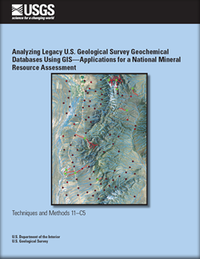This report emphasizes geographic information system analysis and the display of data stored in the legacy U.S. Geological Survey National Geochemical Database for use in mineral resource investigations. Geochemical analyses of soils, stream sediments, and rocks that are archived in the National Geochemical Database provide an extensive data source for investigating geochemical anomalies. A study area in the Egan Range of east-central Nevada was used to develop a geographic information system analysis methodology for two different geochemical datasets involving detailed (Bureau of Land Management Wilderness) and reconnaissance-scale (National Uranium Resource Evaluation) investigations. ArcGIS was used to analyze and thematically map geochemical information at point locations. Watershed-boundary datasets served as a geographic reference to relate potentially anomalous sample sites with hydrologic unit codes at varying scales. The National Hydrography Dataset was analyzed with Hydrography Event Management and ArcGIS Utility Network Analyst tools to delineate potential sediment-sample provenance along a stream network. These tools can be used to track potential upstream-sediment-contributing areas to a sample site. This methodology identifies geochemically anomalous sample sites, watersheds, and streams that could help focus mineral resource investigations in the field.


